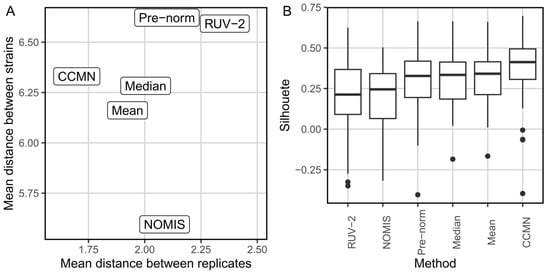Journal Description
BioChem
BioChem
is an international, peer-reviewed, open access journal on biochemistry published quarterly online by MDPI.
- Open Access— free for readers, with article processing charges (APC) paid by authors or their institutions.
- Rapid Publication: manuscripts are peer-reviewed and a first decision is provided to authors approximately 54 days after submission; acceptance to publication is undertaken in 16.5 days (median values for papers published in this journal in the second half of 2023).
- Recognition of Reviewers: APC discount vouchers, optional signed peer review, and reviewer names published annually in the journal.
Latest Articles
Bioinformatic Analysis of Metabolomic Data: From Raw Spectra to Biological Insight
BioChem 2024, 4(2), 90-114; https://doi.org/10.3390/biochem4020005 - 16 Apr 2024
Abstract
►
Show Figures
Metabolites are at the end of the gene–transcript–protein–metabolism cascade. As such, metabolomics is the omics approach that offers the most direct correlation with phenotype. This allows, where genomics, transcriptomics and proteomics fail to explain a trait, metabolomics to possibly provide an answer. Complex
[...] Read more.
Metabolites are at the end of the gene–transcript–protein–metabolism cascade. As such, metabolomics is the omics approach that offers the most direct correlation with phenotype. This allows, where genomics, transcriptomics and proteomics fail to explain a trait, metabolomics to possibly provide an answer. Complex phenotypes, which are determined by the influence of multiple small-effect alleles, are an example of these situations. Consequently, the interest in metabolomics has increased exponentially in recent years. As a newer discipline, metabolomic bioinformatic analysis pipelines are not as standardized as in the other omics approaches. In this review, we synthesized the different steps that need to be carried out to obtain biological insight from annotated metabolite abundance raw data. These steps were grouped into three different modules: preprocessing, statistical analysis, and metabolic pathway enrichment. We included within each one of them the different state-of-the-art procedures and tools that can be used depending on the characteristics of the study, providing details about each method’s characteristics and the issues the reader might encounter. Finally, we introduce genome-scale metabolic modeling as a tool for obtaining pseudo-metabolomic data in situations where their acquisition is difficult, enabling the analysis of the resulting data with the modules of the described workflow.
Full article
Open AccessReview
New Insights into Hsp90 Structural Plasticity Revealed by cryoEM
by
Karine Minari, Vitor Hugo Balasco Serrão and Júlio César Borges
BioChem 2024, 4(2), 62-89; https://doi.org/10.3390/biochem4020004 - 04 Apr 2024
Abstract
►▼
Show Figures
Heat Shock Protein 90 (Hsp90) acts as a crucial molecular chaperone, playing an essential role in activating numerous signaling proteins. The intricate mechanism of Hsp90 involving ATPase-coupled conformational changes and interactions with cochaperone proteins has been elucidated through biochemical and structural analyses, revealing
[...] Read more.
Heat Shock Protein 90 (Hsp90) acts as a crucial molecular chaperone, playing an essential role in activating numerous signaling proteins. The intricate mechanism of Hsp90 involving ATPase-coupled conformational changes and interactions with cochaperone proteins has been elucidated through biochemical and structural analyses, revealing its activation mechanism and its diverse set of “client” proteins. Despite recent advancements, certain aspects of Hsp90’s ATPase-coupled mechanism remain contentious, and the specific nature of the alterations induced by Hsp90 in client proteins remains largely undiscovered. In this review, we explore the current understanding of Hsp90’s structure and function, drawing insights from single-particle cryoEM studies. Structural studies on Hsp90 using cryoEM have provided valuable insights into the structural dynamics and interactions of this molecular chaperone. CryoEM structures have been instrumental in understanding the ATPase-coupled conformational changes that Hsp90 undergoes during its chaperone cycle. We also highlight recent progress in elucidating the structure of the ATP-bound state of the complete dimeric chaperone. Furthermore, we delve into the roles played by the multitude of cochaperones that collaborate with Hsp90, providing a glimpse into their biochemical mechanisms through the newly obtained cryoEM structures of Hsp90 cochaperone complexes.
Full article
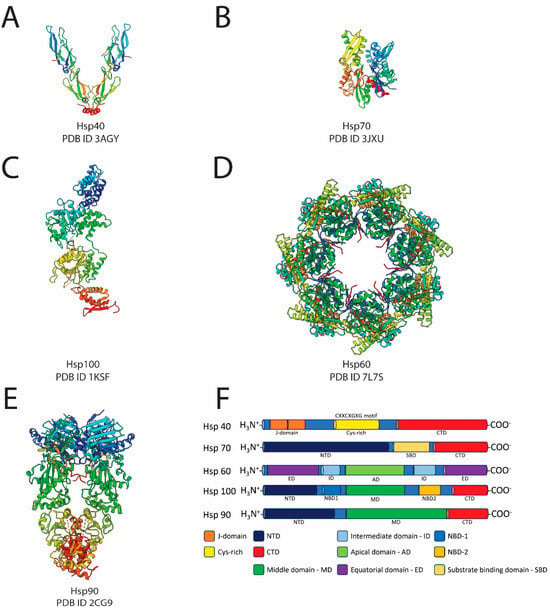
Figure 1
Open AccessReview
Flavonoids and Flavonoid-Based Nanoparticles for Osteoarthritis and Rheumatoid Arthritis Management
by
Hicham Wahnou, Youness Limami and Mounia Oudghiri
BioChem 2024, 4(1), 38-61; https://doi.org/10.3390/biochem4010003 - 13 Mar 2024
Abstract
►▼
Show Figures
Arthritis, a global health burden comprising osteoarthritis and rheumatoid arthritis, demands advanced therapeutic approaches. In this context, flavonoids, a diverse group of naturally occurring compounds abundant in fruits, vegetables, and medicinal plants, have emerged as promising candidates for mitigating the inflammatory processes associated
[...] Read more.
Arthritis, a global health burden comprising osteoarthritis and rheumatoid arthritis, demands advanced therapeutic approaches. In this context, flavonoids, a diverse group of naturally occurring compounds abundant in fruits, vegetables, and medicinal plants, have emerged as promising candidates for mitigating the inflammatory processes associated with arthritic conditions. This review aims, first, to provide a comprehensive exploration of the potential of flavonoids, focusing on specific compounds such as quercetin, epigallocatechin-3-gallate (EGCG), apigenin, luteolin, fisetin, silibinin, kaempferol, naringenin, and myricetin. The second section of this review delves into the anti-arthritic activities of these flavonoids, drawing insights from clinical trials and scientific studies. Each flavonoid is scrutinized individually to elucidate its mechanisms of action and therapeutic efficacy in the context of both osteoarthritis and rheumatoid arthritis. The third section of this review highlights the challenges associated with harnessing flavonoids for anti-inflammatory purposes. Bioavailability limitations pose a significant hurdle, prompting the exploration of innovative strategies such as the use of nanoparticles as delivery vehicles. In response to these challenges, the fourth section focuses on the emerging field of flavonoid-based nanoparticles. This includes detailed discussions on quercetin, EGCG, fisetin, and naringenin-based nanoparticles, highlighting formulation strategies and preclinical evidence supporting their potential in arthritis management. The targeted delivery to inflammatory sites and the exploration of synergistic combinations with other compounds are also discussed as promising avenues to enhance the therapeutic impact of flavonoids. This review consolidates current knowledge on flavonoids and their nanoformulations as potential therapeutic interventions for osteoarthritis and rheumatoid arthritis. By addressing challenges and presenting future research directions, this review aims to contribute to the advancement of innovative and effective strategies for alleviating the global burden of arthritis.
Full article
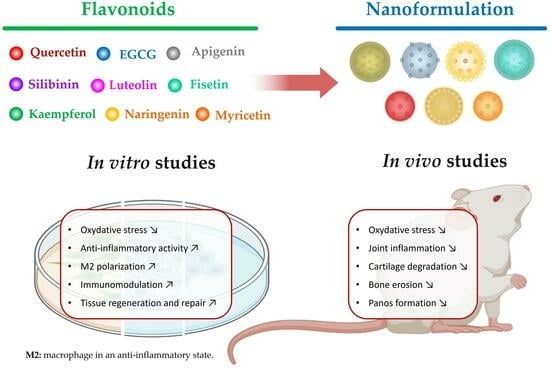
Graphical abstract
Open AccessArticle
Inhibition of Lactate Dehydrogenase-A by Singlet Oxygen and Hypochlorous Acid via Cysteine Oxidation and Irreversible Conformational Changes
by
Lisa Landino, Lydia Boike and Taylor Lain
BioChem 2024, 4(1), 18-37; https://doi.org/10.3390/biochem4010002 - 02 Feb 2024
Abstract
►▼
Show Figures
Muscle lactate dehydrogenase (LDH-A) catalyzes the reduction of pyruvate to lactate, the end product of anaerobic glycolysis. LDH-A is overexpressed in many cancers prior to and even when tumors receive adequate oxygen, and lactate has multiple cellular roles. We assessed the effect of
[...] Read more.
Muscle lactate dehydrogenase (LDH-A) catalyzes the reduction of pyruvate to lactate, the end product of anaerobic glycolysis. LDH-A is overexpressed in many cancers prior to and even when tumors receive adequate oxygen, and lactate has multiple cellular roles. We assessed the effect of singlet oxygen and hypochlorous acid (HOCl) on mammalian LDH-A. Oxidants induced distinct patterns of protein crosslinks observed by SDS-PAGE under reducing conditions. LDH-A cysteines were detected using fluorescein-modified maleimide to assess their oxidation and accessibility. Singlet oxygen initially increased cysteine exposure, but higher doses resulted in their oxidation in addition to non-reducible covalent crosslinks. LDH-A cysteines were oxidized by micromolar HOCl (1–10 equivalents over enzyme) but were resistant to millimolar H2O2, chloramines and Angeli’s salt. HOCl oxidation inhibited LDH-A activity and yielded inter-chain disulfides observed by nonreducing SDS-PAGE. Disulfide reduction did not restore LDH-A activity that was lost due to HOCl oxidation. An irreversible conformational change induced by HOCl was detected by native gel electrophoresis and tryptophan fluorescence. In the absence of pyruvate, LDH-A enhanced NADH oxidation resulting in H2O2 formation. Singlet oxygen, but not HOCl, initiated this superoxide-dependent chain reaction. Once damaged by both singlet oxygen or HOCl, LDH-A had decreased NADH oxidation activity.
Full article
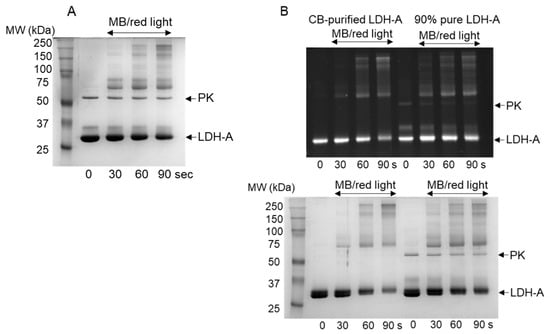
Figure 1
Open AccessArticle
Electrospun Polyurethane Vascular Grafts for Cerebral Revascularization: A Pilot Study on Rats
by
Evelynn Vergauwen, Michiel R. L. Tubeeckx, Annemie Houben, Sandra Van Vlierberghe, Marc Demolder, Guido R. Y. De Meyer, Patrick Pauwels and Tomas Menovsky
BioChem 2024, 4(1), 1-17; https://doi.org/10.3390/biochem4010001 - 05 Jan 2024
Abstract
►▼
Show Figures
The current standard technique for vascular grafting in cerebral revascularization surgery employs the interposition of an autologous blood vessel. Technical complications have necessitated the development of a synthetic alternative, but classical biomaterials are not suited for small caliber vascular grafting due to the
[...] Read more.
The current standard technique for vascular grafting in cerebral revascularization surgery employs the interposition of an autologous blood vessel. Technical complications have necessitated the development of a synthetic alternative, but classical biomaterials are not suited for small caliber vascular grafting due to the resulting neointimal hyperplasia and thrombosis. The electrospinning of polymers is a promising technique for the development of small vascular grafts. The in vivo performance and efficacy of electrospun polyurethane (ePU) grafts with an internal diameter of <1.5 mm have thus far not been evaluated. We developed a novel ePU graft, with a diameter of 1.25 mm, for implantation into the infrarenal aorta of rats. The patency rates of grafts after a 4-month period were equal to those reported in other studies using larger ePU graft diameters and equal or higher than in studies employing other biomaterials. We observed some loss in flow velocity throughout the grafts, which suggests a decreased elasticity of the graft compared to that of the native rat aorta. However, the grafts demonstrated good neo-endothelialization and minimal neointimal hyperplasia. Their porosity promoted cellular infiltration, as observed under tissue slide examination. Our results show that ePU vascular grafts with an internal diameter of <1.5 mm are promising candidates for vascular grafting in cerebral revascularization surgery.
Full article
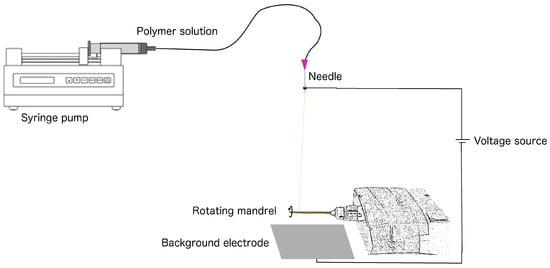
Figure 1
Open AccessReview
Role of MOB4 in Cell Proliferation and Neurogenesis
by
Inês B. Santos, Juan Garrido-Maraver, Carolina Gonçalves, Bruna I. Oliveira and Álvaro A. Tavares
BioChem 2023, 3(4), 182-196; https://doi.org/10.3390/biochem3040013 - 06 Dec 2023
Abstract
Signaling pathways that integrate a large set of inputs (both extra- and intracellular) to control cell proliferation are essential during both development and adult stages to guarantee organism homeostasis. Mobs are small adaptor proteins that participate in several of these signaling pathways. Here,
[...] Read more.
Signaling pathways that integrate a large set of inputs (both extra- and intracellular) to control cell proliferation are essential during both development and adult stages to guarantee organism homeostasis. Mobs are small adaptor proteins that participate in several of these signaling pathways. Here, we review recent advances unravelling Mob4 cellular functions, a highly conserved non-catalytic protein, that plays a diversity of roles in cell proliferation, sperm cell differentiation and is simultaneously involved in synapse formation and neural development. In addition, the gene is often overexpressed in a large diversity of tumors and is linked to poor clinical outcomes. Nevertheless, Mob4 molecular functions remain poorly defined, although it integrates the core structure of STRIPAK, a kinase/phosphatase protein complex, that can act upstream of the Hippo pathway. In this review we focus on the recent findings of Mob4 functions, that have begun to clarify its critical role on cell proliferation and the development of tissues and individuals.
Full article
(This article belongs to the Special Issue Selected Papers from XXI SPB National Congress of Biochemistry 2021)
►▼
Show Figures

Figure 1
Open AccessArticle
Metabolic Effects on Mouse Embryonic Stem Cells and the Canonical Mammalian Target of Rapamycin Pathway
by
Bibiana Correia, Maria Inês Sousa and João Ramalho-Santos
BioChem 2023, 3(4), 170-181; https://doi.org/10.3390/biochem3040012 - 09 Nov 2023
Abstract
►▼
Show Figures
Diapause-like features can be extended to naïve mouse embryonic stem cells (mESCs) to induce paused pluripotency by using INK128 (mTi), a mammalian target of rapamycin (mTOR) inhibitor. As a core integrative pathway, mTOR senses diverse stimuli and translates these cues to coordinate several
[...] Read more.
Diapause-like features can be extended to naïve mouse embryonic stem cells (mESCs) to induce paused pluripotency by using INK128 (mTi), a mammalian target of rapamycin (mTOR) inhibitor. As a core integrative pathway, mTOR senses diverse stimuli and translates these cues to coordinate several processes. We have previously shown that the withdrawal of leucine and arginine from the culture medium of naïve mESCs can induce features of a paused-pluripotent state, including reduced cell proliferation, cell cycle arrest, and reductions in glycolytic and oxidative metabolism. However, surprisingly, although mTi did indeed provoke a paused-like state, this was distinct from and less pronounced than what resulted from leucine and arginine removal, and, according to our results, these features did not seem to necessarily be mTOR-driven. Therefore, this possibility should be considered in further experiments, and mTOR inhibition when using INK128 should always be confirmed and not merely assumed when INK128 is present in the culture medium.
Full article
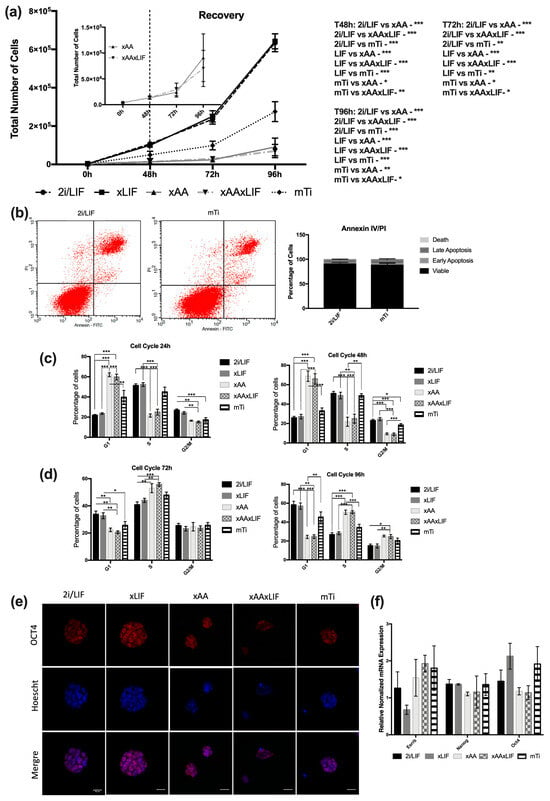
Figure 1
Open AccessArticle
Cytotoxic Effects of Indonesian Betel Quid Components on Oral Keratinocytes and Fibroblasts
by
Elizabeth Fitriana Sari, Ali I. Mohammed, Antonio Celentano, Michael John McCullough and Nicola Cirillo
BioChem 2023, 3(4), 153-169; https://doi.org/10.3390/biochem3040011 - 23 Oct 2023
Abstract
►▼
Show Figures
A betel quid (BQ) chewing habit has been strongly associated with the development of several oral mucosal diseases. In order to investigate whether individual components of BQ mixtures have distinct physio-pathological effects on oral mucosal cells, we examined the impact of areca nut
[...] Read more.
A betel quid (BQ) chewing habit has been strongly associated with the development of several oral mucosal diseases. In order to investigate whether individual components of BQ mixtures have distinct physio-pathological effects on oral mucosal cells, we examined the impact of areca nut (AN), Piper betle leaf (Leaf), Piper betle stem inflorescence (SI), areca husk (Husk) and the complete BQ mixture on the growth of oral keratinocytes (OKF-6) and primary oral fibroblasts (MMF-1). Based on their known chemical properties, we selected BQ samples from Banda Aceh (BA) and West Papua (WP) regions for our in vitro study. We used a fluorescein diacetate assay (FDA) to assess the cell viability of BQ components on OKF-6 and MMF-1 cells. The cytotoxic effect of WP-AN on the OKF-6 cell line was observed at a concentration of 100 μg/mL, resulting in a 50% reduction in cell viability (IC50) after a 2-day incubation. Similarly, BA-AN exhibited cytotoxic effect, although at a higher concentration (500 μg/mL). WP-SI also displayed cytotoxic effects at a concentration of 500 μg/mL following 2 days of incubation. In contrast, Leaf, BQ mixture and husk extracts did not show any cytotoxic effects even after 3 days of incubation. No cytotoxic effects were observed at any concentration of BQ components when exposed to MMF-1 cells. Regarding cell proliferation, MMF-1 cells exposed to BA-AN and WP-AN showed increased growth on day 1, followed by decreased growth on day 2, in a dose- and time-dependent manner. Overall, our study indicates that BQ components induce distinctive cytotoxic effects on stromal and epithelial cells from the oral cavity.
Full article
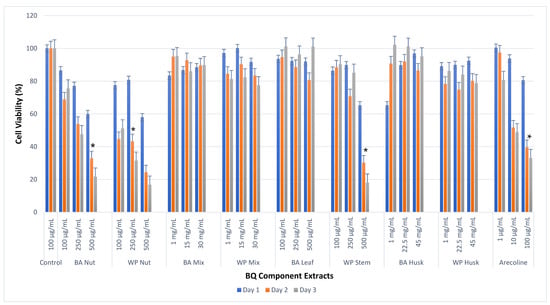
Figure 1
Open AccessArticle
New Method of Isothermal, Hairpin Assisted, Primer Independent Amplification of DNA
by
Denis Sergeevich Naberezhnov, Alexander Andreevich Alferov, Yuriy Borisovich Kuzmin and Nikolay Evgenievich Kushlinskii
BioChem 2023, 3(3), 142-152; https://doi.org/10.3390/biochem3030010 - 19 Sep 2023
Abstract
The isothermal amplification of nucleic acids refers to processes that quickly increase the amount of DNA at a constant temperature. These methods are mainly developed as alternatives to PCR for cases in which the application of a thermal cycler is not possible or
[...] Read more.
The isothermal amplification of nucleic acids refers to processes that quickly increase the amount of DNA at a constant temperature. These methods are mainly developed as alternatives to PCR for cases in which the application of a thermal cycler is not possible or the assay method must be as rapid as possible. We have developed a new method of isothermal amplification based on the formation of hairpins at the ends of DNA fragments containing palindromic sequences and increased by the hydrolysis of one or both DNA strands by restriction endonuclease, known as hairpin-assisted isothermal reaction (HAIR). The key steps in HAIR are the formation of a self-complementary hairpin and the DNA breakage introduced by nickase. The end hairpins facilitate primer-free amplification, the amplicon strand cleavage by nickase produces additional 3′ ends that serve as new amplification points, and the amount of DNA can increase exponentially. The rate of amplification in HAIR is more than five times the rate of loop-mediated isothermal amplification (LAMP), and the total amount of DNA product of HAIR is more than double the amount of the LAMP product.
Full article
(This article belongs to the Special Issue RNA and Protein Dynamics: Latest Advances and Prospects)
►▼
Show Figures
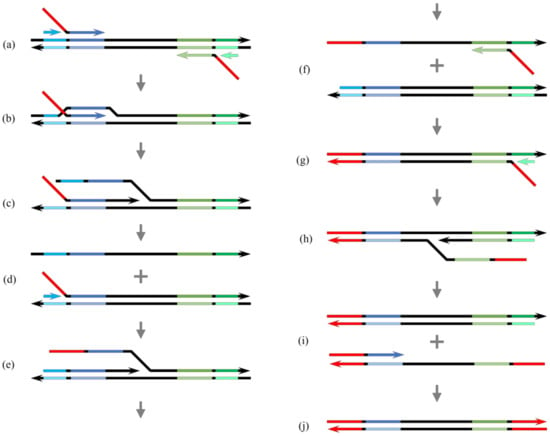
Figure 1
Open AccessReview
Combined Therapies with Taxane-Based Chemotherapeutic Drugs in Prostate Cancer: Novel Insights and Future Directions
by
Rafaella S. Coelho, Sandra M. Rocha and Cláudio J. Maia
BioChem 2023, 3(3), 118-141; https://doi.org/10.3390/biochem3030009 - 29 Aug 2023
Abstract
►▼
Show Figures
Oncologic disease is a significant global health issue that causes thousands of deaths annually, and it has a significant impact on the quality of life of patients. Prostate cancer (PCa) is the second most diagnosed cancer and the fourth leading cause of cancer-related
[...] Read more.
Oncologic disease is a significant global health issue that causes thousands of deaths annually, and it has a significant impact on the quality of life of patients. Prostate cancer (PCa) is the second most diagnosed cancer and the fourth leading cause of cancer-related death in men in the Western world. Delineation of pathogenetic pathways and key driver molecular alterations involved in PCa development has provided a roadmap for the evaluation of biomarkers in predicting disease outcome and to identify potential therapeutic targets. Chemotherapeutic agents introduced from the 1990s include the taxanes (paclitaxel, docetaxel, and cabazitaxel), which are the anticancer drugs used most frequently for PCa treatment. This review presents the current knowledge about the onset and development of PCa, the state of the art of the use of taxane-based therapy, and their combination with targeting different transmembrane oncoproteins in PCa. The silencing of some transmembrane proteins can improve taxane sensitivity, and therefore may be a mechanism to improve the effectiveness of these drugs in PCa treatment. This combined therapy needs to be explored as a potential therapeutic agent for reducing cell proliferation, migration, and invasiveness in PCa.
Full article
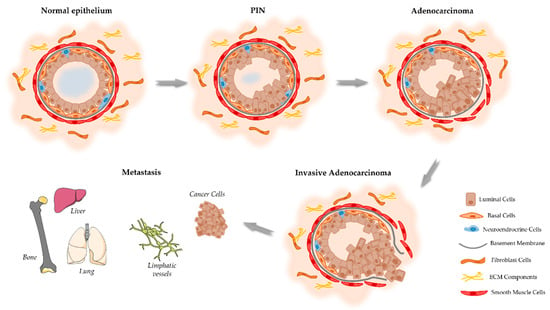
Figure 1
Open AccessArticle
Qualitative Shotgun Proteomics Strategy for Protein Expression Profiling of Fish Otoliths
by
Rick M. Rideout, Trevena N. Youssef, Aaron T. Adamack, Rince John, Alejandro M. Cohen, Travis D. Fridgen and Joseph H. Banoub
BioChem 2023, 3(3), 102-117; https://doi.org/10.3390/biochem3030008 - 28 Jul 2023
Abstract
►▼
Show Figures
Despite decades of research on fish otoliths and their capacity to serve as biochronological recorders, much remains unknown about their protein composition, the mechanisms by which proteins are incorporated into the otolith matrix, or the potential for using otolith proteins to provide insight
[...] Read more.
Despite decades of research on fish otoliths and their capacity to serve as biochronological recorders, much remains unknown about their protein composition, the mechanisms by which proteins are incorporated into the otolith matrix, or the potential for using otolith proteins to provide insight into aspects of fish life history. We examined the protein composition of Atlantic cod (Gadus morhua) otoliths using a state-of-the-art shotgun proteomics approach with liquid chromatography coupled to an electrospray ionization-orbitrap tandem mass spectrometer. In addition to previously known otolith matrix proteins, we discovered over 2000 proteins not previously identified in cod otoliths and more than 1500 proteins not previously identified in any fish otoliths. These included three novel proteins (Somatolactin, F-actin-capping protein subunit beta, Annexin) primarily involved in binding calcium ions and likely mediating crystal nucleation. However, most of the otolith proteins were not necessarily related to otolith formation but rather to other aspects of fish physiology. For example, we identified sex-related biomarkers for males (SPATA6 protein) and females (Vitellogenin-2-like protein). We highlight some noteworthy classes of proteins having diverse functions; however, the primary goal here is not to discuss each protein separately. The number and diverse roles of the proteins discovered in the otoliths suggest that proteomics could reveal critical life history information from archived otolith collections that could be invaluable for understanding aspects of fish biology and population ecology. This proof-of-concept methodology paper provides a novel methodology whereby otolith proteomics can be further explored.
Full article
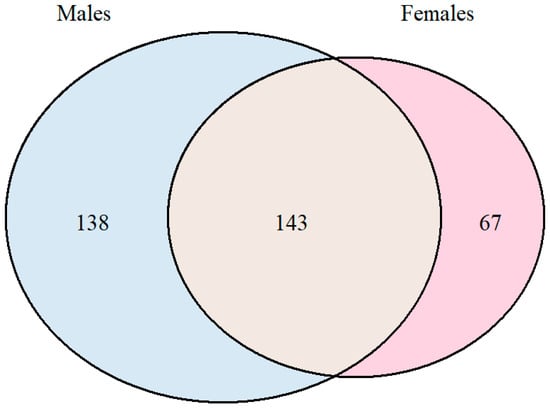
Figure 1
Open AccessCommunication
DMSO Alleviates LPS-Induced Inflammatory Responses in RAW264.7 Macrophages by Inhibiting NF-κB and MAPK Activation
by
Hyunju Han, Jin-Kyu Kang, Keun Jae Ahn and Chang-Gu Hyun
BioChem 2023, 3(2), 91-101; https://doi.org/10.3390/biochem3020007 - 14 Jun 2023
Abstract
►▼
Show Figures
Dimethyl sulfoxide (DMSO), an amphipathic molecule composed of one highly polar sulfinyl group and two nonpolar methyl groups, is considered an excellent solvent due to its capability to dissolve many polar and nonpolar compounds. Therefore, DMSO is widely used to solubilize drugs for
[...] Read more.
Dimethyl sulfoxide (DMSO), an amphipathic molecule composed of one highly polar sulfinyl group and two nonpolar methyl groups, is considered an excellent solvent due to its capability to dissolve many polar and nonpolar compounds. Therefore, DMSO is widely used to solubilize drugs for therapeutic applications. DMSO is reported to possess anti-inflammatory, anticancer, and antioxidative capacities, and the anti-inflammatory efficacy of DMSO has been intensively studied in various cell lines and animal models. An in vitro model of mouse macrophage RAW 264.7 cells has been widely used, among several experimental designs, for evaluation during the development of new anti-inflammatory drugs. DMSO, which is used to dissolve samples, is also prone to experimental errors because of its anti-inflammatory properties. Therefore, we systematically confirmed the cytotoxic and anti-inflammatory effects of DMSO and the related signaling pathways in RAW 264.7 cells. The results show that DMSO at 0.25% to 1.5% did not result in cellular toxicity, with results comparable to the control group where DMSO is absent; at concentrations 2.0%, however, it inhibited the viability of RAW264.7 cells (13.25%). The results demonstrate that pretreatment with DMSO profoundly attenuates the lipopolysaccharide (LPS)-stimulated levels of nitric oxide (NO) and prostaglandin (PG)E2, as well as the levels of pro-inflammatory cytokines, cyclooxygenase-2 (COX-2) protein, and inducible nitric oxide synthase (iNOS). Collectively, the DMSO pretreatments appear to notably alleviate LPS-induced damage by reducing phosphorylation of p38, c-Jun N-terminal kinase (JNK), and extracellular signal-regulated kinase proteins (ERKs), nuclear factor-kappa-B (NF-κB) in addition to NF-κB/p65 nuclear translocation. Taken together, the results clearly show that DMSO attenuates the inflammatory response in LPS-induced RAW264.7 cells by regulating the activation of the MAPK and NF-κB signaling pathways. These results contribute to potentially reducing experimental errors or misjudgments when using the LPS-induced RAW 264.7 macrophage cell model for evaluation during the development of new anti-inflammatory drugs.
Full article

Figure 1
Open AccessArticle
Nitric Oxide Production from Nitrite plus Ascorbate during Ischemia upon Hippocampal Glutamate NMDA Receptor Stimulation
by
Carla Nunes and João Laranjinha
BioChem 2023, 3(2), 78-90; https://doi.org/10.3390/biochem3020006 - 03 May 2023
Cited by 2
Abstract
Nitric oxide (•NO), a diffusible free radical, is an intercellular messenger, playing a crucial role in several key brain physiological processes, including in neurovascular coupling (NVC). In the brain, glutamatergic activation of the neuronal nitric oxide synthase (nNOS) enzyme constitutes its
[...] Read more.
Nitric oxide (•NO), a diffusible free radical, is an intercellular messenger, playing a crucial role in several key brain physiological processes, including in neurovascular coupling (NVC). In the brain, glutamatergic activation of the neuronal nitric oxide synthase (nNOS) enzyme constitutes its main synthesis pathway. However, when oxygen (O2) supply is compromised, such as in stroke, ischemia, and aging, such •NO production pathway may be seriously impaired. In this context, evidence suggests that, as already observed in the gastric compartment, the reduction of nitrite by dietary compounds (such as ascorbate and polyphenols) or by specific enzymes may occur in the brain, constituting an important rescuing or complementary mechanism of •NO production. Here, using microsensors selective for •NO, we show that nitrite enhanced the •NO production in a concentration-dependent manner and in the presence of ascorbate evoked by N-methyl-D-aspartate (NMDA) and glutamate stimulation of rat hippocampal slices. Additionally, nitrite potentiated the •NO production induced by oxygen-glucose deprivation (OGD). Overall, these observations support the notion of a redox interaction of ascorbate with nitrite yielding •NO upon neuronal glutamatergic activation and given the critical role of NO as the direct mediator of neurovascular coupling may represents a key physiological mechanism by which •NO production for cerebral blood flow (CBF) responses to neuronal activation is sustained under hypoxic/acidic conditions in the brain.
Full article
(This article belongs to the Special Issue Selected Papers from XXI SPB National Congress of Biochemistry 2021)
►▼
Show Figures
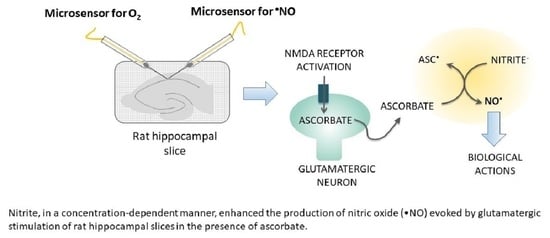
Graphical abstract
Open AccessArticle
Fluorinated Derivatives of Digalloyl-Flavan-3-ol Induce Autophagic Cell Death by Forming Granular Aggregates Containing Mitochondria
by
Ryo Doge, Yuki Nishino and Akiko Saito
BioChem 2023, 3(2), 61-77; https://doi.org/10.3390/biochem3020005 - 17 Apr 2023
Cited by 1
Abstract
Flavan-3-ol derivatives are polyphenolic compounds with multifunctional properties. One of the flavan-3-ol derivatives, green tea catechin epigallocatechin gallate, is known to have anticancer activity as one of its multifunctional properties. We have studied the synthesis of flavan-3-ol derivatives and conducted structure-activity relationship studies;
[...] Read more.
Flavan-3-ol derivatives are polyphenolic compounds with multifunctional properties. One of the flavan-3-ol derivatives, green tea catechin epigallocatechin gallate, is known to have anticancer activity as one of its multifunctional properties. We have studied the synthesis of flavan-3-ol derivatives and conducted structure-activity relationship studies; we found that the fluorinated derivatives exhibited high toxicity against HeLa and A549 cells. It was confirmed that the cytotoxicity was affected by the conformation of the flavan-3-ol skeleton and that the 2,3-cis form was dominant. The addition of fluorinated compounds increased the amount of intracellular mitochondrial superoxide, abolished the membrane potential of mitochondria, and, interestingly, formed granular aggregates containing mitochondria. When the level of LC3-II, a marker of autophagy induction, was confirmed, it suggested that the addition of the fluorinated compounds promoted autophagy. These results suggest that the novel highly cytotoxic fluorinated flavan-3-ol compound synthesized in this study promotes autophagy and induces cell death by triggering mitochondrial dysfunction. We believe that these results suggest the possibility of conferring more functionality through structural transformations of flavan-3-ol derivatives.
Full article
(This article belongs to the Special Issue Cancer Molecular Biology and Drug Discovery)
►▼
Show Figures
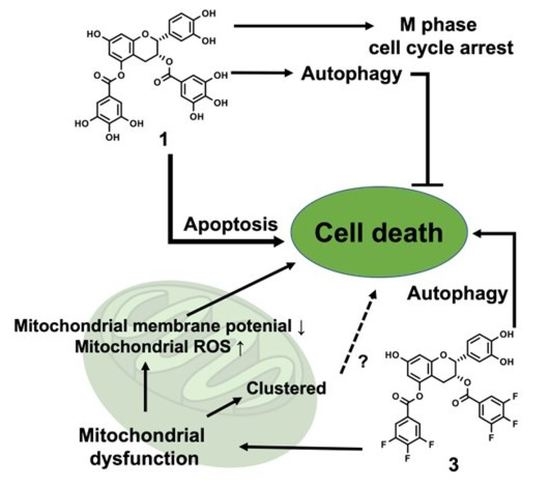
Graphical abstract
Open AccessReview
The Cross-Talk between Microbiome and Metabolome in Rheumatoid Arthritis
by
Lidia La Barbera, Chiara Rizzo, Giulia Grasso, Federica Macaluso, Federica Camarda, Francesco Ciccia and Giuliana Guggino
BioChem 2023, 3(1), 47-60; https://doi.org/10.3390/biochem3010004 - 13 Mar 2023
Cited by 1
Abstract
►▼
Show Figures
Modern “omics” sciences, including metabolomics and microbiomics, are currently being applied to inflammatory autoimmune diseases, such as rheumatoid arthritis (RA), to investigate the interplay between microbiota, metabolic function, and the immune system. In recent decades, robust evidence has suggested that disruption of the
[...] Read more.
Modern “omics” sciences, including metabolomics and microbiomics, are currently being applied to inflammatory autoimmune diseases, such as rheumatoid arthritis (RA), to investigate the interplay between microbiota, metabolic function, and the immune system. In recent decades, robust evidence has suggested that disruption of the normal composition of the microbiome, known as dysbiosis, in the gut and mouth of RA patients contributes to immune dysregulation and alterations in the metabolic pathways, shaping the pathogenesis of the disease and playing a central role in the risk and progression of RA. Metabolic pathways can be influenced by various agents such as the surrounding environment, lifestyle, and exposure to microbiota imbalance. In turn, the body’s metabolic homeostasis influences the immune response, making metabolomics helpful not only to understand pathogenesis pathways, but also to improve early disease detection and therapeutic chances. Combined gut microbiome and metabolome studies set out to unravel the interactions between these two entities, providing insights to discover new treatment targets and potential biomarkers to prevent joint damage. The purpose of this review is to summarize the main recent findings that suggest promising new research directions for the pathogenesis of RA.
Full article
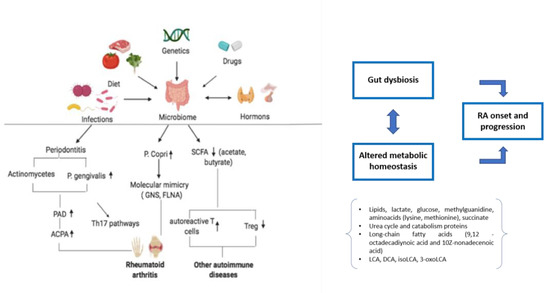
Figure 1
Open AccessReview
Intracellular Organization of Proteins and Nucleic Acids via Biomolecular Condensates in Human Health and Diseases
by
Raffaella Gallo
BioChem 2023, 3(1), 31-46; https://doi.org/10.3390/biochem3010003 - 01 Feb 2023
Abstract
Eukaryotic cells are intracellularly divided into several compartments that provide spatiotemporal control over biochemical reactions. Phase separation of proteins and RNA is emerging as an important mechanism underlying the formation of intracellular compartments that are not delimited by membranes. These structures are also
[...] Read more.
Eukaryotic cells are intracellularly divided into several compartments that provide spatiotemporal control over biochemical reactions. Phase separation of proteins and RNA is emerging as an important mechanism underlying the formation of intracellular compartments that are not delimited by membranes. These structures are also known as biomolecular condensates and have been shown to serve a myriad of cellular functions, such as organization of cytoplasm and nucleoplasm, stress response, signal transduction, gene regulation, and immune response. Here, the author will summarize our current understanding of intracellular phase separation, its biological functions, and how this phenomenon is regulated in eukaryotic cells. Additionally, the author will review recent evidence of the role of biomolecular condensates in the development of pathophysiological conditions, with special emphasis on cancer and immune signaling.
Full article
(This article belongs to the Special Issue RNA and Protein Dynamics: Latest Advances and Prospects)
►▼
Show Figures
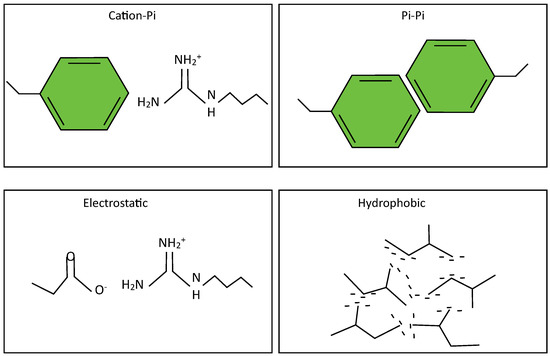
Figure 1
Open AccessArticle
pH-Selective Reactions to Selectively Reduce Cancer Cell Proliferation: Effect of CaS Nanostructures in Human Skin Melanoma and Benign Fibroblasts
by
Olga M. Rodríguez Martínez, Michelle A. Narváez Ramos, Angeliz A. Soto Acevedo, Carolina C. Colón Colón, Darlene Malavé Ramos, Coral Castro Rivera and Miguel E. Castro Rosario
BioChem 2023, 3(1), 15-30; https://doi.org/10.3390/biochem3010002 - 18 Jan 2023
Cited by 1
Abstract
►▼
Show Figures
An acidic extracellular pH value (pHe) is characteristic of many cancers, in contrast to the physiologic pHe found in most benign cells. This difference in pH offers a unique opportunity to design and engineer chemicals that can be employed for
[...] Read more.
An acidic extracellular pH value (pHe) is characteristic of many cancers, in contrast to the physiologic pHe found in most benign cells. This difference in pH offers a unique opportunity to design and engineer chemicals that can be employed for pH-selective reactions in the extracellular fluid of cancer cells. The viability of human skin melanoma and corresponding fibroblasts exposed to CaS dispersions is reported. The viability of melanoma cells decreases with CaS dispersion concentration and reaches 57% at 3%, a value easily distinguishable from melanoma control experiments. In contrast, the viability of benign fibroblasts remains nearly constant within experimental error over the range of dispersion concentrations studied. The CaS dispersions facilitate vinculin delocalization in the cytoplasmic fluid, a result consistent with improved focal adhesion kinase (FAK) regulation in melanoma cells. Thermodynamic considerations are consistent with the formation of H2S from CaS in the presence of protons. The thermodynamic prediction is verified in independent experiments with solid CaS and acidic aqueous solutions. The amount of H2S formed decreases with pH. An activation energy for the process of (30 ± 10) kJ/mol in the temperature range of 280 to 330 K is estimated from initial rate measurements as a function of temperature. The total Gibbs energy minimization approach was employed to establish the distribution of sulfides—including H2S in the gas and aqueous phases—from the dissociation of CaS as a function of pH to mimic physiologically relevant pH values. Theoretical calculations suggest that partially protonated CaS in solution can be stable until the sulfur atom bonds to two hydrogen atoms, resulting in the formation of Ca2+ and H2S, which can be solvated and/or released to the gas phase. Our results are consistent with a model in which CaS is dissociated in the extracellular fluid of melanoma cells selectively. The results are discussed in the context of the potential biomedical applications of CaS dispersions in cancer therapies.
Full article
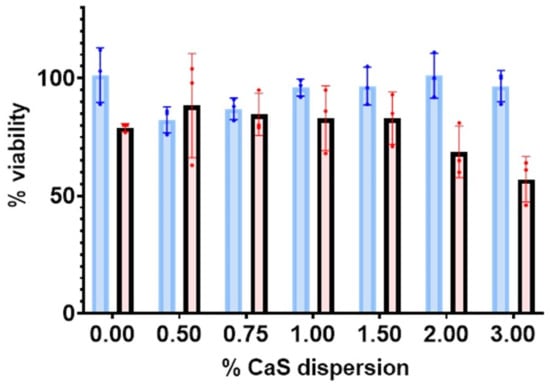
Figure 1
Open AccessReview
Current Technical Approaches to Study RNA–Protein Interactions in mRNAs and Long Non-Coding RNAs
by
Johanna Mattay
BioChem 2023, 3(1), 1-14; https://doi.org/10.3390/biochem3010001 - 30 Dec 2022
Cited by 1
Abstract
It is commonly understood that RNA-binding proteins crucially determine the fate of their target RNAs. Vice versa, RNAs are becoming increasingly recognized for their functions in protein regulation and the dynamics of RNA-protein complexes. Long non-coding RNAs are emerging as potent regulators of
[...] Read more.
It is commonly understood that RNA-binding proteins crucially determine the fate of their target RNAs. Vice versa, RNAs are becoming increasingly recognized for their functions in protein regulation and the dynamics of RNA-protein complexes. Long non-coding RNAs are emerging as potent regulators of proteins that exert unknown RNA-binding properties and moonlighting functions. A vast array of RNA- and protein-centric techniques have been developed for the identification of protein and RNA targets, respectively, including unbiased protein mass spectrometry and next-generation RNA sequencing as readout. Determining true physiological RNA and protein targets is challenging as RNA–protein interaction is highly dynamic, tissue- and cell-type-specific, and changes with the environment. Here I review current techniques for the analysis of RNA–protein interactions in living cells and in vitro. RNA-centric techniques are presented on the basis of cross-linking or the use of alternative approaches. Protein-centric approaches are discussed in combination with high-throughput sequencing. Finally, the impact of mutations in RNA–protein complexes on human disease is highlighted.
Full article
(This article belongs to the Special Issue RNA and Protein Dynamics: Latest Advances and Prospects)
►▼
Show Figures
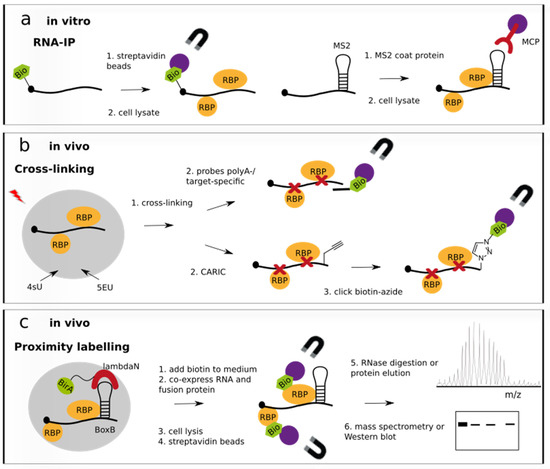
Figure 1
Open AccessArticle
Synergistic Antibacterial Activity of Green Gold Nanoparticles and Tannin-Based Derivatives
by
Elisângela Gomes De Lima Oliveira, Simone Araújo Vieira, Fernando Antônio Gomes Da Silva, Jr., Mateus Matiuzzi Da Costa, Anderson S. L. Gomes and Helinando P. De Oliveira
BioChem 2022, 2(4), 269-279; https://doi.org/10.3390/biochem2040019 - 15 Dec 2022
Cited by 4
Abstract
The development of composites with antibacterial activity represents an important strategy to avoid side effects such as increasing bacterial resistance to antibiotics. In particular, the green synthesis of metal nanoparticles avoids the use of hazardous chemical compounds and introduces the intrinsic beneficial properties
[...] Read more.
The development of composites with antibacterial activity represents an important strategy to avoid side effects such as increasing bacterial resistance to antibiotics. In particular, the green synthesis of metal nanoparticles avoids the use of hazardous chemical compounds and introduces the intrinsic beneficial properties of plant-derived compounds. Herein, the reduction of gold salt into metal nanoparticles was provided by the action of a cationic polymer derived from tannin (Tanfloc®). Comparative activity of antibacterial agents (pure Tanfloc and Au NPs—Tanfloc) at different concentrations were evaluated in terms of the antibiofilm activity, kill-time assays and inhibition haloes confirming the antibacterial activity of the Tanfloc that is reinforced by the incorporation of reduced gold nanoparticles, resulting in the complete elimination of S. aureus from an initial concentration of 108 CFU/mL after 120 min of reaction of Au NPs + Tanfloc solution in association with strong inhibition of the biofilm formation attributed to the Tanfloc.
Full article
(This article belongs to the Topic Biological Activity of Plant Extracts)
►▼
Show Figures

Figure 1
Open AccessArticle
Oil Spill in Brazil—Analysis of Vulnerabilities and Socio-Environmental Conflicts
by
Mariana Olívia Santana dos Santos, Mariana Maciel Nepomuceno, José Erivaldo Gonçalves, Ana Catarina Leite Véras Medeiros, Rafaella Miranda Machado, Caroline Pontes da Silva Santos, Maria José Cremilda Ferreira Alves, Aline do Monte Gurgel and Idê Gomes Dantas Gurgel
BioChem 2022, 2(4), 260-268; https://doi.org/10.3390/biochem2040018 - 09 Dec 2022
Abstract
The 2019 oil spill was considered the largest environmental disaster in the Brazilian Northeastern coast. It was associated with mostly ineffective government actions, thus intensifying historical vulnerabilities faced by local populations. We aimed to analyze the environmental conflicts and injustices and the socio-environmental,
[...] Read more.
The 2019 oil spill was considered the largest environmental disaster in the Brazilian Northeastern coast. It was associated with mostly ineffective government actions, thus intensifying historical vulnerabilities faced by local populations. We aimed to analyze the environmental conflicts and injustices and the socio-environmental, economic, and health vulnerabilities arising from the oil spill, considering the COVID-19 pandemic, impacting artisanal fishing communities of the Northeastern coast. A document-based, qualitative, cross-sectional research was carried out between September 2019 and October 2022, in open access secondary databases, and using field diaries from research of the Environmental Health and Work Laboratory (LASAT) of the Aggeu Magalhães Institute of the Oswaldo Cruz Foundation. The disaster caused situations of injustice and environmental conflicts that had negative repercussions in the territories with socioeconomic impacts, on the environment, and on the health of the population. The entire marine environment was affected, resulting in physical and chemical alterations. The health vulnerabilities faced by local people were intensified, influencing the social determination of the health–disease process. The local economy was extremely affected, generating job insecurity and several socio-cultural problems. It is essential to build environmental and health diagnoses for remedial measures in disasters such as the oil spill.
Full article
Highly Accessed Articles
Latest Books
E-Mail Alert
News
Topics
Topic in
BioChem, Biomedicines, Biomolecules, IJMS, Metabolites, Molecules
Natural Products in Prevention and Therapy of Metabolic Syndrome
Topic Editors: Jianbo Wan, Ligen LinDeadline: 30 June 2024
Topic in
Antioxidants, BioChem, Biomolecules, Cells, Molecules, IJMS
Recent Advances in Oxidoreductases Biochemistry and Biotechnology
Topic Editors: Grzegorz Janusz, Anna Pawlik, Clemens Karl PeterbauerDeadline: 31 October 2024
Topic in
Antioxidants, BioChem, Biomolecules, Cells, IJMS, Nutrients, Pharmaceutics, Foods
Bioactive Compounds with Application Potentials in Nutraceuticals and Nutricosmetics: Focus on Mechanism of Action and Application Science
Topic Editors: Pujie Shi, Tiantian Lin, Lin Chen, Xin Yang, Caili Fu, Hyun-Gyun Yuk, Rong FanDeadline: 31 December 2024
Topic in
BioChem, Biomolecules, CIMB, Molecules, Pharmaceutics, Sci. Pharm.
Design, Synthesis and Biological Evaluation of Novel Small Molecules as Multi-target Enzyme Inhibitors
Topic Editors: Davide Moi, Daniele Passarella, Andrea CitarellaDeadline: 31 January 2025

Conferences
Special Issues
Special Issue in
BioChem
Plant-Derived Bioactive Molecules and Their Use in Sports Practice
Guest Editors: Guglielmo Duranti, Piergiorgio La RosaDeadline: 25 April 2024
Special Issue in
BioChem
Thirty Years of Biochemistry Course at the University of Algarve (1993–2023)
Guest Editors: Manuel Aureliano, Dorinda Marques-da-Silva, Vanessa A. Morais, Maria João PereiraDeadline: 31 July 2024
Special Issue in
BioChem
Therapeutic Resolution of Pulmonary Arterial Hypertension
Guest Editor: Talat NasimDeadline: 31 August 2024

